Aphid is a dangerous harmful insect living in symbiosis with ants. The presence of the latter on the site is one of the main reasons for the colonization of plants by pest colonies. It is possible to fight aphids on plantings of cucumbers both by chemical, biological methods of protection, and alternative methods. The last is to process the bushes after flowering. Although less effective, it is safer than using pesticides.
Content
Pest Summary
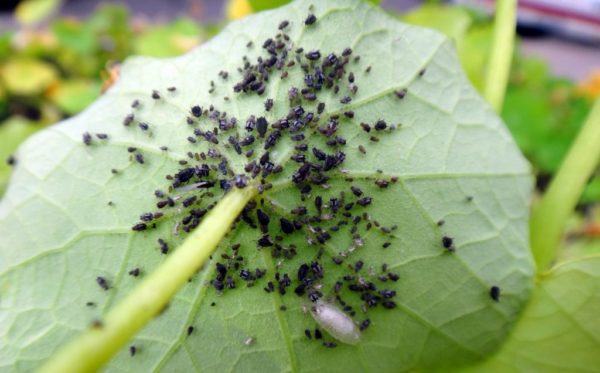
On cucumbers - and in the beds, and in the greenhouse - gourd aphids are noted. Her green shoots of plants are subjected to her attacks, from which she sucks the juice. Flightless adults have a green-yellow color. Winged - it is black or swamp. Less commonly, microscopic pests with a white, almost transparent color are noted on the vegetable crop. Since black aphids on cucumbers live in colonies, it is easier to deal with it: as the shoots populate, dark spots become noticeable to the naked eye.
The size of aphids is 1-2 mm. In the photo it is presented to scale. Habitats - the underside of the shoots. A temperature above 6 ° C causes the pest to actively reproduce. In the course of its life, aphids carry various infections and feed on plant sap, draining them. Insect secretions also have a detrimental effect on cucumbers. Sticky liquid covers the leaves, leading to a deterioration in the process of photosynthesis in them. But with ants, honey dew allows the pest to live in symbiosis. These "workers" feed on substance, therefore they protect and even protect the aphids that secrete it.
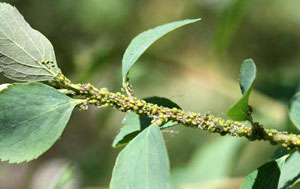 You may be interested in:
You may be interested in:Reasons for appearance and signs of settlement
The time of planting seedlings of cucumbers or the appearance of seedlings coincides with the beginning of the settlement of crops by the pest. The main wintering stock of larvae and wingless females is concentrated in weeds, on basal leaf blades, from where they begin to "expand". The main reasons for the appearance of gourds aphids on cucumbers:
- the presence of ants in the country (household) plot;
- violation of crop rotation;
- preservation of plant debris in the beds since autumn.
In order to timely destroy the pest and preserve the crop, you should systematically inspect the plantings, to control how they look. The following signs help to determine the presence of both green and black aphids on cucumbers:
- torsion of leaves - when the pest appears and begins to feed, the edges are bent down;
- falling ovary;
- deformation of the apex of the processes;
- slow growth and development of the plant;
- low intensity of fruit formation;
- the appearance of a large number of ants;
- general wilting of landings;
- yellowing and death of young shoots.
How to deal with aphids on cucumbers
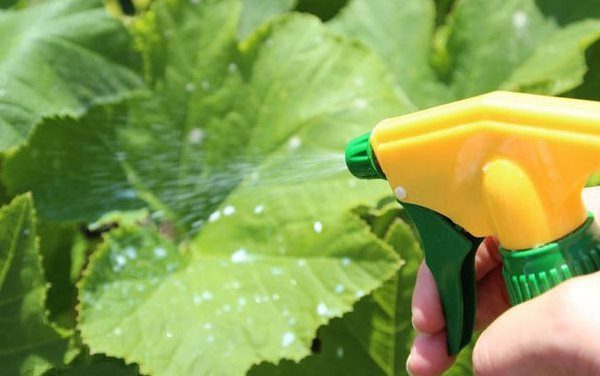
There are several methods to protect plantings from pests. If the aphid appeared on the shoots of cucumbers, you can use folk remedies, pesticides or the biological method. Insecticides have established themselves as high-speed drugs. However, during the fruiting period, processing of cucumbers from aphids with their help is unacceptable due to the preservation of the pesticidal residue in the fruits.
Chemical Remedies
Insecticides are effective, high-speed aphid control agents on cucumbers both in a greenhouse, in a greenhouse, and in open ground. Unlike other methods, they show excellent results with large-scale settlement.
A single treatment can destroy almost all aphids. However, chemical preparations have restrictions on their use, since they have the following characteristics:- toxic to bees - do not spray during flowering;
- long period of toxicity - after processing, the product can not be eaten for 3-30 days, depending on the active substance.
To protect vegetable plantings, insecticides of systemic and contact action are used. However, the effectiveness of the former is higher, since it allows you to fight against aphids that feed on cucumbers from below the leaves. There is no need to try to get on the pest, because the drug penetrates the plant system and makes the juice poisonous to the insect.
Table. The Most Effective Chemicals for Melon and Gourd
| Name | Preparation of working fluid, ml of preparation / l of water | The waiting period, days | Application Nuances |
|
"Commander" |
1 / 2 | 3 |
Sprayed from aphids on cucumbers in a greenhouse |
|
"Fufanon" |
5 / 5 | 20 |
Processed vegetable plantations in calm weather in the morning or after sunset |
|
Karbofos |
10 / 20 | ||
|
Actellik |
5 / 10 |
Folk remedies against aphids on cucumbers
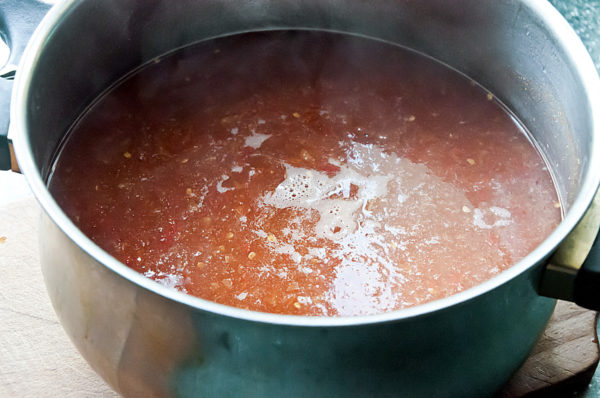
The pest can attack the shoots at any stage of development. In the phases of flowering, ovary and fruiting, aphids on cucumbers should be treated with folk remedies, since they do not have a toxic effect on the vegetable crop. However, the final disposal of leaves from numerous colonies of a harmful insect is a lengthy process. Such infusions are effective:
- Tobacco - 400 g of tobacco mixture, 80 g of laundry soap are sent to a bucket of hot water, everything is insisted for a day. After the specified time, the solution is filtered and used for spraying. Etching aphids should be a large amount of infusion, abundantly wetting the shoots.
- Ash - to save plants from the attacks of harmful insects, 200 g of ash and a piece of laundry soap weighing 50 g are bred in a bucket of water. Freshly prepared infusion is sprayed with shoots of vegetable culture.
- Mustard - a solution of 10 g of powder and 1 liter of water will help protect cucumbers. Insist it for 48 hours, then add a slightly smaller amount of clean water and 60 g of soap shavings.
- Garlic - in 1 liter of water, gruel from 200 g of vegetable cloves is stirred. The mixture is kept for a week, and then filtered and diluted with clean water in a 1: 10 ratio. Garlic infusion is especially effective in greenhouse conditions when pests only appear in the colony.
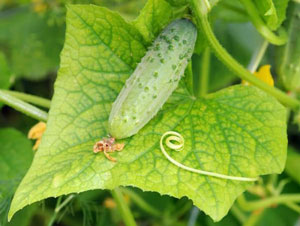 You may be interested in:
You may be interested in:There are other nutritional supplements and medical preparations on the farm. With their help, you can safely and efficiently process the planting of cucumbers from the "miniature" pest:
- Vinegar from melons and gourds - 30 ml of essence is poured into 10 liters of water. To remove the pest, the treatment is carried out immediately after preparation of the solution. Against a large number of aphids, vinegar only helps with repeated spraying.
- Hydrogen peroxide solution - 50 ml of peroxide are diluted in 1 liter of water. After adding a stack of sugar, you can get rid of pests by several sprinkles at intervals of a week.
- Ammonium chloride - dilute the product in water at the rate of 50 ml per 10 l, adding up to 50 g of crushed laundry soap. Spraying frequency - every week. If there are not many bushes, insects can be removed by wiping the leaves with a sponge soaked in a solution.
Biological control method
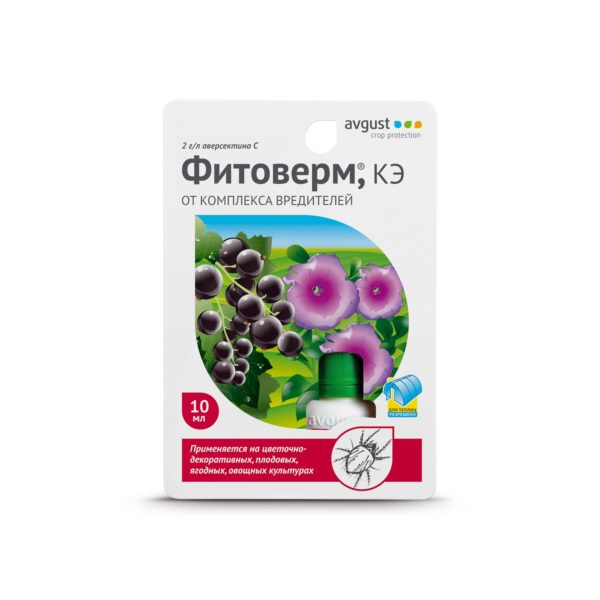
Other safe products that are harmless to birds and ladybirds will also help get rid of aphids on the shoots of cucumbers. You can spray them with bushes in the conditions of home cultivation (on the windowsill, loggias). After the use of biological products, products can be consumed by people already on the fifth day. This is due to the presence of a natural component in the composition. The latter accounts for the bulk.
There are many biological products. Vegetable growers use them as a more environmentally friendly way to control aphids on cucumbers, in comparison with chemicals:
- “Fitoverm” - I process plantings at any stage of development (seedlings, flowering, fruiting). Previously, 10 ampoules are dissolved in 10 l of water.
- "Entobacterin" - spraying is carried out a week before the planned date of removal of greenhouses. The working solution is prepared from 10 g of the drug and 1 l of water.
- “Tanrek” - the period of protection of the product is a month. Due to the addition of laundry soap to the working fluid (5 ml of biological product per bucket of water) as an adhesive, precipitation does not reduce the term of the harmful effects of the drug on insects.
- "Arrow" - the tool demonstrates effectiveness in double processing, carried out with a two-week interval. The composition of the working solution includes 50 g of granules and 10 l of water.
 You may be interested in:
You may be interested in:Preventative methods

Urgent protective treatments often require aggressive anti-aphid measures that multiply very quickly, causing permanent damage to the plantings. It is better to protect cucumbers from pest attacks in advance by observing the agrotechnics of growing this crop. The main preventive measures:
- When preparing the site for cucumbers, in the autumn, remove all plant debris that can serve as a litter for the wintering supply of the pest, as well as pour copper sulfate solution during the digging to destroy larvae and pathogenic organisms.
- To introduce culture into the crop rotation without planting it after bad predecessors, as a result of cultivation of which numerous specialized pests and diseases remain on the site.
- During the growing season, destroy weeds, which are an intermediate link for the transfer of aphids to cucumbers.
- Apply integrated plant protection, including biological methods - placing nearby garlic that repels aphids or mustard that attracts ladybirds.
- Fight ants and do not place beds near their "dwellings".
An important agrotechnical measure that helps to protect the crop of cucumbers from aphids is feeding. Due to the timeliness of their introduction, the bushes have excellent immunity. The first top dressing is carried out 14 days after transplanting seedlings in open ground or emergence using a mullein solution in a ratio of 1: 10. This accelerates the rooting and development of green mass. Further, in the flowering and fruiting phases, fertilizer irrigation is used with the inclusion of superphosphate and potassium sulfate, which strengthen plant health and extend the yield of the crop.
Aphids are a dangerous pest that populates vegetable crops very quickly.The best solution is to spray the plants as a preventative measure and get a rich harvest of high-quality greens.




 Armenian cucumber with melon flavor: description and characteristics, reviews
Armenian cucumber with melon flavor: description and characteristics, reviews Do-it-yourself vertical beds for cucumbers: schemes, photos
Do-it-yourself vertical beds for cucumbers: schemes, photos Hollow cucumbers: reasons for the appearance of hollow, what to do
Hollow cucumbers: reasons for the appearance of hollow, what to do Which manure is best for cucumbers: application, how to breed
Which manure is best for cucumbers: application, how to breed